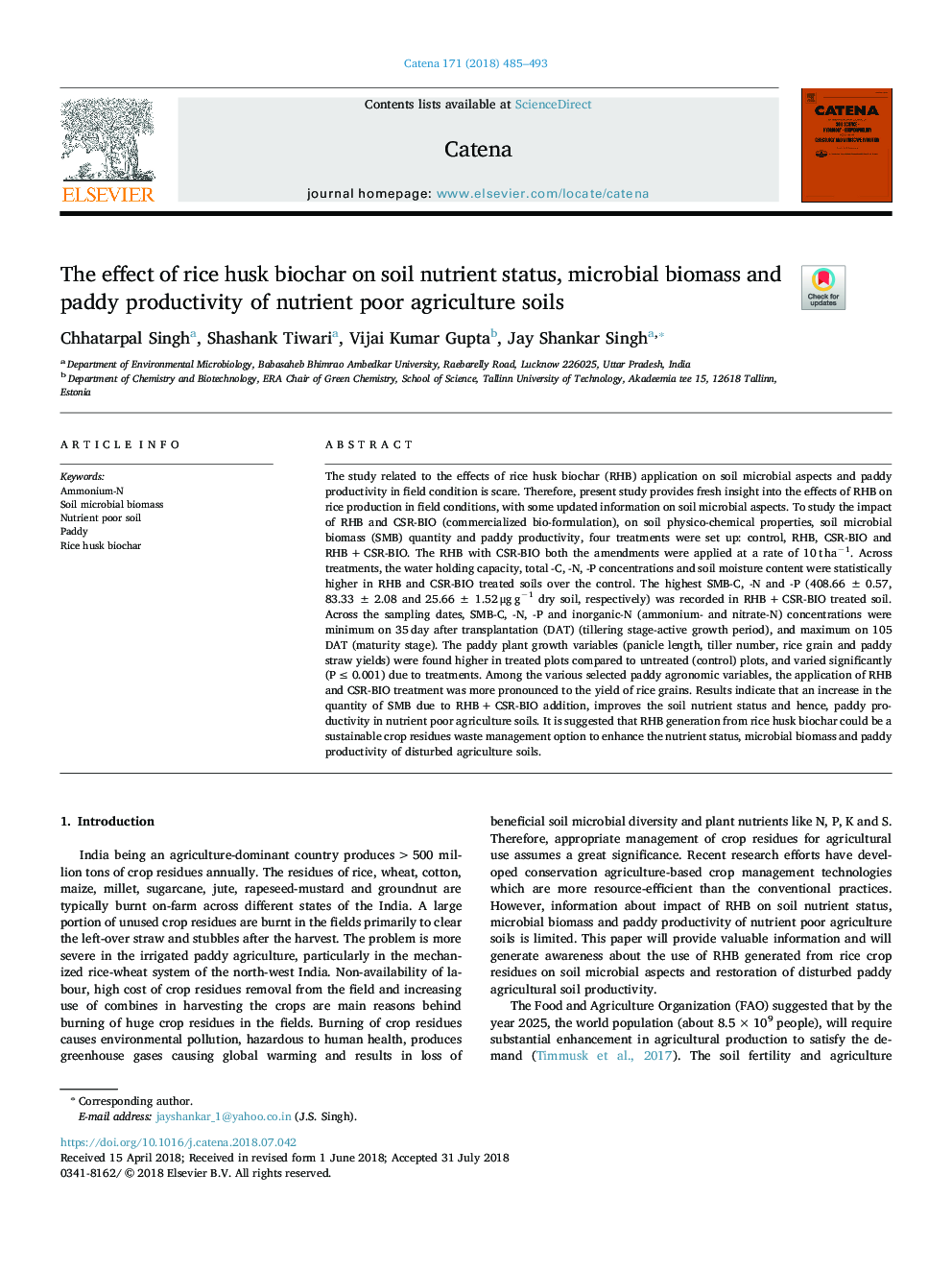| کد مقاله | کد نشریه | سال انتشار | مقاله انگلیسی | نسخه تمام متن |
|---|---|---|---|---|
| 8893383 | 1629183 | 2018 | 9 صفحه PDF | دانلود رایگان |
عنوان انگلیسی مقاله ISI
The effect of rice husk biochar on soil nutrient status, microbial biomass and paddy productivity of nutrient poor agriculture soils
ترجمه فارسی عنوان
اثر زیست بذر چغندر برنج بر وضعیت مواد مغذی خاک، بیوماس میکروبی و بهره وری بذر خاک های زراعی فقیر
دانلود مقاله + سفارش ترجمه
دانلود مقاله ISI انگلیسی
رایگان برای ایرانیان
موضوعات مرتبط
مهندسی و علوم پایه
علوم زمین و سیارات
فرآیندهای سطح زمین
چکیده انگلیسی
The study related to the effects of rice husk biochar (RHB) application on soil microbial aspects and paddy productivity in field condition is scare. Therefore, present study provides fresh insight into the effects of RHB on rice production in field conditions, with some updated information on soil microbial aspects. To study the impact of RHB and CSR-BIO (commercialized bio-formulation), on soil physico-chemical properties, soil microbial biomass (SMB) quantity and paddy productivity, four treatments were set up: control, RHB, CSR-BIO and RHBâ¯+â¯CSR-BIO. The RHB with CSR-BIO both the amendments were applied at a rate of 10â¯tâ¯haâ1. Across treatments, the water holding capacity, total -C, -N, -P concentrations and soil moisture content were statistically higher in RHB and CSR-BIO treated soils over the control. The highest SMB-C, -N and -P (408.66â¯Â±â¯0.57, 83.33â¯Â±â¯2.08 and 25.66â¯Â±â¯1.52â¯Î¼gâ¯gâ1 dry soil, respectively) was recorded in RHBâ¯+â¯CSR-BIO treated soil. Across the sampling dates, SMB-C, -N, -P and inorganic-N (ammonium- and nitrate-N) concentrations were minimum on 35â¯day after transplantation (DAT) (tillering stage-active growth period), and maximum on 105 DAT (maturity stage). The paddy plant growth variables (panicle length, tiller number, rice grain and paddy straw yields) were found higher in treated plots compared to untreated (control) plots, and varied significantly (Pâ¯â¤â¯0.001) due to treatments. Among the various selected paddy agronomic variables, the application of RHB and CSR-BIO treatment was more pronounced to the yield of rice grains. Results indicate that an increase in the quantity of SMB due to RHBâ¯+â¯CSR-BIO addition, improves the soil nutrient status and hence, paddy productivity in nutrient poor agriculture soils. It is suggested that RHB generation from rice husk biochar could be a sustainable crop residues waste management option to enhance the nutrient status, microbial biomass and paddy productivity of disturbed agriculture soils.
ناشر
Database: Elsevier - ScienceDirect (ساینس دایرکت)
Journal: CATENA - Volume 171, December 2018, Pages 485-493
Journal: CATENA - Volume 171, December 2018, Pages 485-493
نویسندگان
Chhatarpal Singh, Shashank Tiwari, Vijai Kumar Gupta, Jay Shankar Singh,
